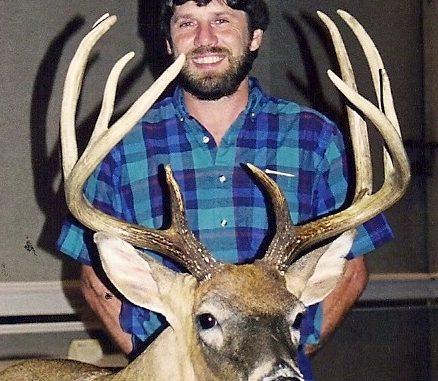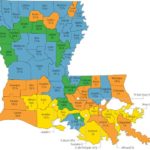
A parish-by-parish study of state records gives a clear picture of where the big boys live, and defines trophies in different areas
When I retired from Wildlife and Fisheries in 2007, I predicted that within five years Louisiana would have a new state record typical buck.
Seven deer seasons have come and gone and the Broadway Buck, killed seven decades ago in Madison Parish by Don Broadway, is still No. 1 at 184 6/8 inches Boone & Crockett. It was taken in 1943.
The closest anyone has come was five decades ago: Ernest McCoy’s Bossier Parish buck taken in 1961 is No. 2 at 184 4/8 B&C.
Every year word gets out that a new state record buck has been killed, and every year when the final measuring is over, the Broadway Buck remains the No. 1 typical.
Generally, these bucks are actually non-typical bucks that are scored green, without taking deductions, and the gross score is used for promoting the buck as a potential new state record. Last season is a prime example, after season Jason Archer, Alex LeBlanc and Phil Major all killed trophies promoted as potential state records. All three were great deer, but also non-typical.
A couple of typicals have come close. During the 2010-11 season Kevin Breaux killed a buck that scored 176 5/8, and during the 2012-13 deer season Travis Lucas killed a buck that scored 175 6/8.
Both were within 10 inches of the Broadway buck.
I have no doubt that a new typical record is going to come; there are just too many landowners and deer managers around the state who are doing an outstanding job with their deer management program.
In 2007, I predicted that the new record would come from Avoyelles Parish and it remains a possibility. Avoyelles has been a consistent producer of huge bucks for several years now. But Pointe Coupee Parish is coming on strong, and of course Concordia, St. Landry and Tensas also are likely candidates for producing the new state typical record.
Add Union Parish to the list, too. It was there last season that Ramona Curole killed a 168 4/8 typical. Union has been the No. 1 deer kill parish in the state for many years and is classified as Piney Woods Habitat.
I am not sure that a new state record could come from woods dominated with pine timber, but who knows.
A matter of habitat
When tasked with choosing the likely spots for a new typical record, I first thought the best way to present this information was to use the various habitat regions in the state or perhaps just the different geographical regions in the state (northwest, northeast, central, etc.).
Many hunters may not know the major habitat classification for their parish or if their parish is considered to be in the central region or northeast region. To simplify it, and thinking that all hunters know the parish they are hunting, the material is being presented parish by parish in alphabetical order.
Not included on the list are the names of the hunters who took the top buck in each parish. The point is to show where the big bucks occur in the state.
I have a notebook that I update annually with the big bucks killed in the state. The notebook begins with Acadia Parish and ends with Winn Parish. I have tried to write all the new record bucks killed every year, but I may have missed a few. Certainly if a buck was never officially scored it will not be on the record list.
That is one of the problems we have with the State Record Program. Not all hunters are interested in having their deer officially scored, so I know there are some trophy bucks hanging on walls that could be on the list for their parish.
One reason for having deer scored is to document what is going on in the various regions and habitats in the state, since trophy bucks are an indicator of good deer and habitat management. They are not the product of low-quality habitat or over-populated deer herds. They are produced through sound management programs.
Not all habitats in the state can produce 160-class deer, but most can produce bucks that score 125 or higher. A 130-class buck is certainly a trophy and indicates good deer management. Hunters and managers should always try to manage within the capabilities and limits of the habitat.
If the management program can be pushed to a higher level, that’s great, but there is nothing wrong with just managing deer within the limits of the habitat and enjoying some good deer hunting.
The age factor is very important when it comes to trophy deer. A buck that is 4 to 6 years old is considered a mature buck and will have a set of antlers that is representative of that age class. But again, not all habitats are equal. Soils differ throughout the state and within individual parishes. Maintaining a healthy deer herd, enjoying some good deer hunting with family and friends and being content with what the land produces is a good deer program.
There are 64 parishes in Louisiana so this is a long list. You might want to take notes as you read through and keep up with a few details.
Has a parish produced 160 class deer?
How often does a parish produce trophy bucks that at least score 130 plus?
How many trophy bucks does a parish produce annually?
This information is contained on the Louisiana Department of Wildlife and Fisheries website under the deer hunting section that contains the Louisiana Big Game Record Lists. State deer biologist Scott Durham works hard to keep the information up to date.
Parish by parish
Acadia Parish: This parish is in the heart of Coastal Prairie Habitat Region of the state. I have no trophy deer in my book for this parish. Rice country is not known for producing big bucks.
Allen Parish: Most of Allen Parish is in the historic longleaf habitat region, which is also not known for producing big bucks. I have a 102-inch typical from West Bay WMA and a 136 7/8-inch typical killed in 2012 by Dylan Quebadeaux, which is a great deer for this parish.
Ascension Parish: Much of Ascension is swamp hardwood, lots of water for deer to elude the hunters. My book has a 136 6/8 typical and a 140 typical. During this past season, Joey Jarreau killed a 137 1/8 typical with his bow. Again this is a great deer for this habitat.
Assumption Parish: Another swamp hardwood parish, this one has no deer in the book.
Avoyelles Parish: I have two pages full of bucks — over 70 — from this bottomland hardwood parish. A productive forest type and lots of agriculture makes this one of the top parishes in the state for producing trophy bucks. A 181 1/8-inch typical and a 209 3/8-inch non-typical are the top deer for this parish. There are some good WMAs available in this leading trophy-deer parish.
Beauregard Parish: This Southwest Louisiana parish is considered historic longleaf habitat and I have nine deer in my book, with the best one being a 152 2/8-inch typical killed in 2013 by Mary Jones. That is a great deer for this parish. Five deer of the nine bucks listed score in the 130’s, which again shows how exceptional Jones’ buck is.
Bienville Parish: I spent many a day in this parish and it is near and dear to my heart. Located in the Northwest Louisiana’s pine/hardwood region, this parish can produce some quality and trophy deer. I have 16 total Bienville deer in my book, including two typical bucks that score 164 and a 165 3/8 non-typical. While this parish has much pine timber, many areas still contain hardwood timber along the streams.
Bossier Parish: This parish is probably best known for big bombers (B-52’s), but it does produce big bucks. McCoy, who was an enforcement agent for LDWF, took his No. 2-ranked typical (184 4/8) here. My book documents 21 trophies; the best non-typical is a 185 7/8 Buck. Loggy Bayou WMA has produced several trophies, and Bossier is also home to the Bodcau WMA, which has a deer season similar to the outside season.
Caddo Parish: Most people think of the City of Shreveport when you mention Caddo Parish, but there is much deer habitat in the parish. Just like Bossier it has both pine/hardwood habitat and bottomland hardwood habitat. The best non-typical scores 219 6/8 and the best typical is 177 1/8. The state’s No. 1 non-typical buck by muzzleloader came out of the Shreveport suburbs, a 203 5/8 B&C killed by youth hunter Greene Campbell. Many may recognize the name differently — now attending Harvard and playing baseball, Campbell made the catch this past season that preserved a win over LSU.
Calcasieu Parish: Another Southwest Louisiana parish in the prairie and historic longleaf habitat. There are six bucks on the page, topped by a 146 2/8 typical and a 167 3/8 non-typical. There is a 120 6/8 typical from Sabine Island WMA.
Caldwell Parish: There are five deer in my book from this Northeast parish, with a 161 typical being the best of the five. This is one of the parishes where I suspect we do not officially score many of the deer that are killed every year.
Cameron Parish: Better known for its waterfowl hunting, there is a 138 2/8 typical from Gum Cove. Coastal marsh habitat is not known for producing big bucks.
Catahoula Parish: A 160 3/8 typical is the best of the seven deer I have listed. Another Northeast Louisiana parish that has pine and hardwood habitat, I fear it is one where we do not measure many of the bucks taken.
Claiborne Parish: In the heart of the Northwest piney woods, this parish can produce trophy bucks. A 177 3/8 typical and a 206 7/8 non-typical are the two top bucks from Claiborne. Kisatchie National Forest is available in this parish.
Concordia Parish: Located along the rich Mississippi River and its bottomland hardwood habitat with lots of agriculture, Concordia certainly ranks among Louisiana’s big-buck parishes. My list shows 177 5/8 as its leading typical and 252 2/8 the best non-typical. Concordia produces non-typical trophy bucks on a regular basis, and boasts of great WMAs.
Desoto Parish: This Northwest pine/hardwood parish with lots of deer habitat can produce 130- to 150-class bucks. The best are a 161 2/8 typical and a 190 2/8 non-typical.
East Baton Rouge Parish: The Red Stick parish has a surprisingly decent deer population for having a big city that serves as the heart of Louisiana politics. A 152 4/8 typical Buck killed with a crossbow tops the list.
East Carroll Parish: Thanks to Willow Point, and its booked bow-hunting operation, this parish within the Mississippi River floodway has the highest number of archery trophies in the state. A 170 3/8 typical bow kill tops the list for this parish.
East Feliciana Parish: This Southeast parish, where I live and play, consists of mixed pine/hardwood habitat, and it does produce both quality and trophy deer. The parish regularly produces 130-class deer, but it is short on 160-class bucks, mainly due to the fact that it has no agriculture except for cattle pastures. A 163 2/8 typical and a 192 6/8 non-typical are the top two bucks.
Evangeline Parish: My book has four bucks from this Southwest parish with prairie habitat, with a 135 1/8 typical heading the list.
Franklin Parish: A century ago, in 1914, this Northeast Louisiana parish produced the state’s No. 3 typical, at 184 2/8 inches. More recently, my list has a 170 typical, a 164 2/8 typical and a 144 2/8 bow-killed typical. Franklin doesn’t produce many bucks, but it has shown excellent quality.
Grant Parish: This Central Louisiana piney woods parish has produced a few B&C entries. The best typical is 173 7/8 and in the top non-typical is 213 1/8. The Catahoula National Wildlife Preserve in the Kisatchie National Forest has produced a couple of trophy bucks.
Iberia Parish: Best known for Avery Island this parish does not produce big bucks. The only two bucks in my book were bow kills: 115 and 96 6/8 inches.
Iberville Parish: The heavy-headed buck killed in the late 50s by Sammy Walker came from this swamp hardwood parish, and would easily be the top parish deer and perhaps rank among the best ever anywhere, but it was not eligible for B&C due to a hormonal imbalance. Iberville does boast a 209 3/8 non-typical and a 155 2/8 typical, not bad for a parish where much of the farmland is in sugar cane, which does not do much for deer.
Jackson Parish: While there’s lots of deer in this Northwest parish, its piney woods don’t produce many big ones. A 163 3/8-inch typical is the only true trophy. Pine-dominated timber just does not grow big deer.
Jefferson Parish: This coastal marsh parish produced a nice 155 1/8 non-typical buck with a palmated rack, the top deer for the parish.
Jeff Davis Parish: No listings for this Southwest parish dominated by prairie habitat.
Lafayette Parish: They may have great football, baseball and softball at the University of Louisiana-Lafayette, but there are no trophy deer in this parish.
Lafourche Parish: In 2013 Travis Fields set the parish record with a 169 6/8 non-typical buck. The other deer on the list was killed in 1991. Coastal marsh habitat has deer, but the nutrition is lacking to regularly produce big bucks.
LaSalle Parish: If you want to kill a trophy deer in this parish head to Dewey Wills WMA. Nine of the 12 deer on the parish list came from this WMA. A 177 7/8-inch typical tops the list followed by a 170 1/8 typical from Dewey Wills.
Lincoln Parish: A few quality bucks have been killed in this Northwest piney woods parish, home of Louisiana Tech, but only one trophy, a 153 7/8 typical.
Livingston Parish: A Southeast Louisiana parish with pine/hardwood habitat, Livingston has always had potential but has never produced trophy bucks. The exception is a 170 6/8 typical.
Madison Parish: Home of the Louisiana record typical Buck, and a few other B&C bucks, this Northeast Louisiana parish has bottomland hardwood habitat and lots of agriculture. Quite a few Pope & Young trophies have come from the Tensas River Refuge with the best one being a 163 1/8 typical.
Morehouse Parish: Home of my good friend and LDWF secretary, Robert Barham, this Northeast Louisiana parish has produced four B&C typical bucks with 170 3/8 being the best of the four.
Natchitoches Parish: This Central Louisiana parish along the I-49 Corridor has produced some nice B&C bucks over the year, headed by a 170 6/8-inch typical. The top non-typical is 185 7/8. It is home to some of the state’s best public land hunting, with a couple of quality bucks topped by a 150 2/8 typical taken on the Red Dirt National Wildlife Preserve.
Orleans Parish: Home to one of the world’s great cities, but not to trophy deer.
Ouachita Parish: This parish is now best known for the show Duck Dynasty and the Robertson clan. Unfortunately, it is not known as a regular producer of trophy bucks. The parish record on my list is 159 2/8 typical, but I think this may be another parish where many deer are never officially scored for our records.
Plaquemines Parish: Want to catch fish? By all means, go to this this coastal marsh habitat parish. Want to kill a big buck? It’s best to look north. I have one Plaquemines buck on my list, a 130 typical.
Pointe Coupee Parish: This bottomland hardwood forest parish also has lots of agriculture for the deer and could one day produce a new state record. A lot of landowners are working hard to produce trophy deer. Phil Major’s 183 4/8-inch non-typical buck is the parish record. A 163 2/8-inch typical buck is the best in that category.
Rapides Parish: Another I-49 Corridor parish, Rapides has produced some trophies and quality bucks on the public land within its borders. A Camp Beauregard WMA buck tops the non-typical list at 198 4/8 inches and was killed with a muzzleloader. The best typical score is 177.
Red River Parish: Some nice non-typical bucks have come out of this Northwest parish dominated by pine habitat. Credit for the trophies probably goes to the agriculture located along the Red River. My list has a 223 1/8-inch non-typical, a 199 6/8 non-typical and a 188 7/8 non-typical. The best typical is a 166 1/8-inch buck.
Richland Parish: Two 170-inch class typical bucks — 177 1/8 and 176 2/8 —have come out of this Northeast parish and that is it as far as trophy deer.
Sabine Parish: Another parish known for its great fishing, thanks to Toledo Bend, but not for producing big bucks. A 162 6/8 typical is the parish record, and a 153 6/8-inch typical was killed in 2012 by Joseph Lavergne on Sabine WMA.
St. Bernard Parish: Filled with swamp hardwood habitat but apparently not with trophy deer; my list has no deer from this parish.
St. Charles Parish: Again, marsh habitat will produce deer, just not big ones. A 119 4/8-inch typical killed on Salvador WMA is the parish record on my list.
St. Helena Parish: Just like Livingston, this parish has always had potential. Dr. Lyle St. Amant wrote about this in his Louisiana Wildlife Inventory book published in the 50s. A great pine/hardwood forest slowly became a dominant pine forest, and pine timber does not grow big bucks. However, over the last two years a couple of 130-plus quality bucks have come from the parish. A 153-inch typical and a 175 non-typical are the top two bucks.
St. James Parish: Another parish with lots of sugar cane and hardwood swamp, and no deer in the book.
St. John Parish: A swamp hardwood parish, a 143 2/8 typical tops its list of four deer. Again, the key to hunting this parish with respect to big bucks is being content with what it produces.
St. Landry Parish: Home of the famous Thistlethwaite WMA, this parish does produce trophy and quality deer as evidenced by the 193 3/8-inch non-typical killed last season by Alex LeBlanc killed. Shawn Ortego’s buck killed on Thistlethwaite scored 180 5/8 and is the parish’s best typical.
St. Martin Parish: In the great Atchafalaya Basin, a non-typical buck killed in 1941 scoring 218 4/8 inches is the best buck for the parish.
St. Mary Parish: The state archery record for typicals, at 175 inches, came from this lower basin and coastal parish. The Atchafalaya Delta WMA has numerous Pope & Young bucks on the parish list. The best buck is a 176 3/8 typical killed in 2011.
St. Tammany Parish: This Southeast parish is becoming highly urbanized and deer habitat is dwindling. The parish records are 153 typical and 157 3/8 non-typical.
Tangipahoa Parish: This Southeast parish was once famous for its dairy farming, has produced a 174 5/8-inch typical. The only other buck on the list is a 131 6/8 typical.
Tensas Parish: Home to bottomland hardwood habitat, rich farmland with high-quality crops deer love to eat and excellent public land, this parish takes up two pages in my book. Tensas has always been known as Louisiana’s big-buck parish, thanks in part to the old Chicago Mills Game Management Area, which is now basically the Tensas River National Wildlife Refuge. The Big Lake and Buckhorn WMAs are also in the parish. The best non-typical buck killed in North America in 1994, James McMurray’s 281 6/8-inch monster, came from this parish and is the state’s record non-typical. The parish’s typical record is 179 7/8 inches.
Terrebonne Parish: For this coastal habitat parish, a 16-point buck scoring 167 non-typical killed in 1963 is its record.
Union Parish: This piney woods parish has the highest deer kill in the state, but the percentage of true trophies is low, but also impressive with six B&C bucks taken. The best is a 179 6/8 typical, No. 8 deer on the state list.
Vermillion Parish: For this coastal habitat parish, a 116 7/8 Typical killed with a bow is the only deer on the list.
Vernon Parish: Longleaf habitat dominates this parish, where a 173 4/8-inch typical tops the seven deer on the list. That buck was killed on Fort Polk WMA, and another nice typical, at 155 7/8 inches, was killed on Peason Ridge WMA.
Washington Parish: A buck scoring 148 2/8 is the best typical buck for this parish, which is dominated by pine forests. I suspect there are some deer hanging in houses killed many years ago that have never been scored that would qualify for the B&C records.
Webster Parish: My native parish, located in the Northwest’s pine/hardwood habitat, does produce quality deer along with a few trophies. Webster’s record typical is 170 5/8 inches, and in 2009 another typical was taken that scored 163 2/8. The non-typical record is 195 7/8.
West Baton Rouge Parish: Known more for quality than record-book deer, this bottomland hardwood habitat parish has a typical best of 151 1/8 and non-typical best of 180 5/8.
West Carroll Parish: The best buck in this Northeast parish is a 151 3/8 typical killed in 2010.
West Feliciana Parish: Prior to 1985 the potential for this parish to produce trophy class bucks was very high. Upland hardwood habitat with good agriculture for deer ended when the Farm Bill Program of 1985 took the land out of agriculture and put it into pine tree plantations. A good hardwood market in the early 90s also reduced the quality of the habitat with much clear-cutting and more pine planting. The parish continues to produce some quality deer, with a typical record of 171 7/8 and a non-typical record of 228 7/8. Lots of 125- to 150-inch Pope&Young bucks have been killed over the years.
Winn Parish: A large parish with pine habitat, Winn has a good deer population and produces quality deer and a few trophies. A couple of nice bucks, 130- and 140-inch class, have recently come from the Winn Ranger District. The parish record is a 170 6/8 typical. This is a parish that does not seem to grow any non-typical bucks.
Summary: Food is the key
It should be clear if you read the complete list that nutrition is the key to producing trophy deer. Age is important but the nutrition must be there for the age factor to work. Louisiana’s most productive habitats are bottomland hardwood timber with agriculture, and mixed pine/hardwood timber. It is the agriculture factor that adds mass to antlers.
If you are not convinced, just look at the chart for the last four deer seasons. Avoyelles, West Feliciana, Concordia, Tensas and East Feliciana are the top five parishes. This may represent the fact that deer killed in the parishes around Baton Rouge, where there are several official measurers, are scored more frequently than in other areas.
The map of the state also shows that most of the big bucks come from the Northwest, Northeast and Central parishes, and that true trophies that score 160 plus are lacking from the southern regions, with the exceptions of St. Mary, St. Landry, Pointe Coupee, East and West Feliciana. The B&C bucks killed in Livingston and Tangipahoa are the only trophies for those parishes and both came several years ago, and for the most part they are similar to the other Southeast parishes.
I agree with the old sports adage, that “records are made to be broken,” and believe that we will see a new state typical record in the near future.
When it comes, it will truly be an historic event. The Broadway Buck has ruled since 1943.







